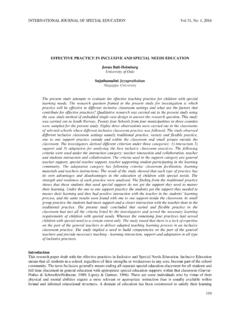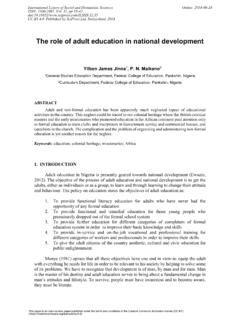Transcription of Children missing education - GOV.UK
1 Children missing education Statutory guidance for local authorities September 2016. Contents Summary 3. About this guidance 3. Review date 3. What legislation does this guidance refer to? 3. Who is this guidance for? 3. What are the main changes from 1 September 2016? 4. Introduction - overview 5. Local authorities' responsibilities 5. Parents' responsibilities 7. Schools' responsibilities 8. Providing information on standard transitions 11. Making reasonable enquiries 12. Using Common Transfer Files to transfer pupil information 14. Sharing information with others 15. Children at particular risk of missing education 16. Further sources of information 19. Associated resources (external links) 19. Additional departmental advice and guidance 19. Annex A: Grounds for deleting a pupil from the school admission register 20.
2 Annex B: CME policies and procedures checklist 22. 2. Summary About this guidance This statutory guidance sets out key principles to enable local authorities in England to implement their legal duty under section 436A of the education Act 1996 to make arrangements to identify, as far as it is possible to do so, Children missing education (CME). Local authorities should be able to demonstrate that they have considered this statutory guidance and where it is not followed, the local authority should have reasonable grounds for not doing so. This advice is not exhaustive and local authorities will need to take into account the circumstances of individual cases. This guidance replaces the January 2015 version. Review date This guidance will next be reviewed by September 2019.
3 What legislation does this guidance refer to? Section 436A of the education Act 1996 (added by section 4 of the education and Inspections Act 2006). education Act 1996 (section 7, 8, 14 and 19). education and Inspections Act 2006 (section 4 and 38). education (Pupil Registration) (England) Regulations 2006. education (Pupil Registration) (Amendment) (England) Regulations 2016. Who is this guidance for? This guidance is for: Local authorities This guidance can be used as a non-statutory advice by: School leaders, school staff and governing bodies in all maintained schools and academies, independent schools Health professionals, Youth Offending Teams, and the police. 3. This guidance also contains information about schools' other statutory duties. What are the main changes from 1 September 2016?
4 All schools (including academies and independent schools) must notify their local authority when they are about to remove a pupil's name from the school admission register under any of the fifteen grounds listed in the regulations 1 (Annex A). This duty does not apply when a pupil's name is removed from the admission register at standard transition points when the pupil has completed the final year of education normally provided by that school unless the local authority requests that such returns are to be made. When removing a pupil's name, the notification to the local authority must include: (a) the full name of the pupil, (b) the full name and address of any parent with whom the pupil normally resides, (c) at least one telephone number of the parent, (d) the pupil's future address and destination school, if applicable, and (e) the ground in regulation 8 under which the pupil's name is to be removed from the admission register (see Annex A).
5 Schools must make reasonable enquiries to establish the whereabouts of the child jointly with the local authority, before deleting the pupil's name from the register if the deletion is under regulation 8(1), sub-paragraphs (f)(iii) and (h)(iii) (see Annex A). All schools must also notify the local authority within five days of adding a pupil's name to the admission register at a non-standard transition point. The notification must include all the details contained in the admission register for the new pupil. This duty does not apply when a pupil's name is entered in the admission register at a standard transition point at the start of the first year of education normally provided by that school unless the local authority requests that such returns are to be made. When adding a pupil's name, the notification to the local authority must include all the details contained in the admission register for the new pupil.
6 1. Regulation 8 of the education (Pupil Registration) (England) Regulations 2006. 4. Introduction - overview 1. All Children , regardless of their circumstances, are entitled to an efficient, full time education which is suitable to their age, ability, aptitude and any special educational needs they may have. 2. Children missing education are Children of compulsory school age who are not registered pupils at a school and are not receiving suitable education otherwise than at a school. Children missing education are at significant risk of underachieving, being victims of harm, exploitation or radicalisation, and becoming NEET (not in education , employment or training) later in life. 3. Effective information sharing between parents, schools and local authorities is critical to ensuring that all Children of compulsory school age are safe and receiving suitable education .
7 Local authorities should focus their resources effectively in intervening early in the lives of vulnerable Children to help prevent poor outcomes. Local authorities' responsibilities 4. Local authorities have a duty under section 436A of the education Act 1996 to make arrangements to establish the identities of Children in their area who are not registered pupils at a school and are not receiving suitable education otherwise. This duty only relates to Children of compulsory school age 2. 5. The local authority should consult the parents of the child when establishing whether the child is receiving suitable education . Those Children identified as not receiving suitable education should be returned to full time education either at a school or in alternative provision. Prompt action and early intervention are crucial to discharging this duty effectively and in ensuring that Children are safe and receiving suitable education .
8 6. Local authorities should have robust policies and procedures in place to enable them to meet their duty in relation to these Children , including ensuring that there 2. A child reaches compulsory school age on or after their fifth birthday. If they turn 5 between 1 January and 31 March, then they are of compulsory school age on 31 March; if they turn 5 between 1 April and 31. August, then they are of compulsory school age on 31 August. If they turn 5 between 1 September and 31. December, then they are of compulsory school age on 31 December. A child continues to be of compulsory school age until the last Friday of June in the school year that they reach sixteen. 5. are effective tracking and enquiry systems in place, and appointing a named person to whom schools and other agencies can make referrals about Children who are missing education .
9 7. Some Children who are missing from education can be identified and supported back into education quickly; other Children who have experienced more complex problems face tougher obstacles to getting back into suitable education . When developing policies and procedures for Children not receiving a suitable education , local authorities should consider the reasons why Children go missing from education and the circumstances that can lead to this happening. 8. Arrangements made under section 436A also play an important role in fulfilling the local authority's wider safeguarding duties. This duty should therefore be viewed alongside these wider duties and local initiatives that aim to promote the safeguarding of Children . 9. Local authorities should have in place arrangements for joint working and information sharing with other local authorities and agencies.
10 Individual local authorities can determine the specific detailed arrangements that work best in their area that not only meet this statutory duty but also enable them to contribute to a range of work aimed at improving outcomes for Children . The Working together to safeguard Children statutory guidance provides advice on inter-agency working to safeguard and promote the welfare of Children . 10. Local authorities should undertake regular reviews and evaluate their policies and procedures to ensure that these continue to be fit for purpose in identifying Children missing education in their area. We have set out a checklist at Annex B. that local authorities may wish to use to satisfy themselves that they have effective systems in place. 11. Where there is concern for a child's welfare, this should be referred to local authority Children 's social care.












